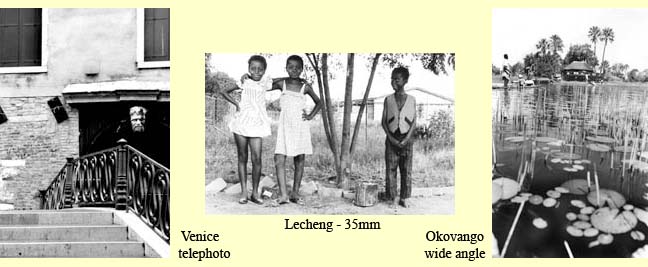JOINER OPTICS: The Lens
The type of lens on your camera plays a part in what your image looks like, and this is true for the single photograph as well as the Joiner photograph.
Different types of lenses
When you look through the viewfinder of a camera or the visual display of your digital camera does it look like what you see with your eye? The unhelpful answer to this is: sometimes, sometimes not.
The standard camera lens of a single lens reflex camera (an SLR - this is one where your viewfinder was essentially a mini periscope that looks through the lens of the camera by means of a mirror in the body that clicks down when the photograph is taken) used to be a 35mm lens focal length. What this meant in real terms was that it approximated what your own eye saw. This makes more sense when you think of other lenses - a wide angle lens sees 'more' than your eye, fitting more of the scene into the same space and essentially changing the relation of things, and a telephoto sees 'less' than your eye but makes the world 'closer' and 'bigger'. Here are some visual examples to help the concept.

The telephoto crushes things in the middle ground and background together. The wide angle shows the far distance and the close foreground in the same shot - notice how there is almost a feeling of vertigo in the way the area close to the camera dips down while other things appear distant and small. The regular lens shows things in a manner that does not surprise the eye, where the relations of objects are as we expect to see them in our everyday observance of the world.
I used to think that a 35mm lens was the only one for joiners in the belief that I should be trying to represent what the eye saw. This was probably naive of me but rules like that help you work through problems one at a time. When I bought my first cheap digital camera I discovered that the default setting of the lens was somewhere between a 35mm view and a 28mm view, which is to say it was a wide angle but not as much as your standard wide angle. For a while I always tried to zoom it to a 35mm setting and then got tired of it. The photographs did distort the images more than I was used to but covered a scene in fewer photographs. This meant less detail and a greater disparity between the parts. As there were greater distortions between pictures this mean more distorting and transforming of the parts in my software program. Initially I was uncomfortable with these choices but it eventually came another way of doing things. Joiners are a distortion of the world. The final say is whether the finished image does what you want.
The one rule to remember is that if the lens is set to around 35mm (I say around because so many cameras now have lenses with the facility to vary the focal length) then the fit between each photograph is better. There will be less discrepancy between edges, less curvature of straight lines, less severity in the angles of elements. Ultimately you have to realise that a joiner must distort the image and transformations of some kind must occur. Try all possibilites, from macro lens to telephoto. What is there to lose?





